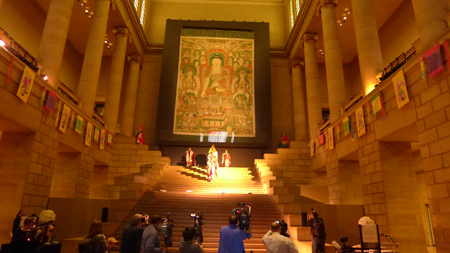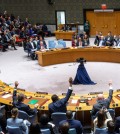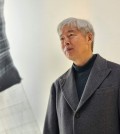- California Assembly OKs highest minimum wage in nation
- S. Korea unveils first graphic cigarette warnings
- US joins with South Korea, Japan in bid to deter North Korea
- LPGA golfer Chun In-gee finally back in action
- S. Korea won’t be top seed in final World Cup qualification round
- US men’s soccer misses 2nd straight Olympics
- US back on track in qualifying with 4-0 win over Guatemala
- High-intensity workout injuries spawn cottage industry
- CDC expands range of Zika mosquitoes into parts of Northeast
- Who knew? ‘The Walking Dead’ is helping families connect
Korean artworks travel to three American museums
Coming to the Los Angeles County Museum of Art from June 29 to Sept. 28

The “Treasures from Korea: Arts and Culture of the Joseon Dynasty, 1392-1910” exhibition opened at the Philadelphia Museum of Art on March 2 and will continue through May 26 before traveling to the Los Angeles County Museum of Art from June 29 to Sept. 28 and the Museum of Fine Arts, Houston from Nov. 2 to Jan. 11, 2015, displaying more than 150 works.
(Courtesy of National Museum of Korea)
By Chung Ah-young
The Joseon Kingdom (1392-1910) is one of the longest-surviving monarchies in the world, shaping the culture of modern Korea in ways that continue to resonate today.
It tickles foreigners’ fancy as the era offers clues to better understand modern Korean manners, norms, and societal attitudes.
A show of Joseon’s culture and history is now captivating the U.S. audience with its time-honored beauty and values.
Organized by the National Museum of Korea, the Philadelphia Museum of Art; the Los Angeles County Museum of Art (LACMA); and the Museum of Fine Arts, Houston (MFAH) are holding or will hold the exhibition of Joseon’s art.
Titled “Treasures from Korea: Arts and Culture of the Joseon Dynasty, 1392-1910,” the exhibition first opened on March 2 in Philadelphia and will continue through May 26 before traveling to Los Angeles from June 29 to Sept. 28 and Houston from Nov. 2 to Jan. 11, 2015.
During the opening ceremony in Philadelphia, a special fashion show for “hanbok” or Korean traditional costume took place on March 2, mesmerizing more than 500 visitors.
The hanbok at the show was designed by Kim Hye-soon who created the traditional costumes for television drama “Hwang Jin-i” and KBS documentary program “Uigwe, 8-Day Festival.”
The Kcul Foundation, a U.S.-based organization to promote Korean culture, said that some 80 amateur models consisting of ballerinas, students and curators living there wore the dress for the show.
The foundation said that the fashion show was successfully held as a preliminary event to grab the attention from the U.S. audience to the Korean traditional culture.
More than 150 works are on exhibit, including the courtly arts of ceremonial screen painting and calligraphy to scenes that vividly portray the lives of diverse social classes, ritual vessels, ceramics and transitional works that were formed between the “Hermit Kingdom” and the Western influence at the end of the 19th century.
A variety of illustrated books, metalwork, sculpture, lacquer, furniture, costumes, textiles, and photographs are on display to demonstrate the breadth of the artistic achievement of the Joseon Kingdom. Most of them are being presented to the U.S. audience for the first time.
The exhibition is part of cultural exchange to raise understanding and friendship between the U.S. and Korea and a reciprocal event after the American artworks from the collections of the Philadelphia Museum of Art, LACMA, and MFAH were exhibited at the National Museum of Korea and the Daejeon Museum of Art last year.
The exhibition offers a wide range of scopes that can penetrate the Joseon Kingdom which saw the succession of 27 kings over 518 years.
It shows how the king and his royal court affected art and culture throughout the kingdom and how simplicity was cultivated at this time and how it was expressed in ceramics and other artworks.
Also, the artworks demonstrate Joseon’s rigid social hierarchies that defined the limited roles of class and gender, while Confucianism produced a variety of ritual implements in metal and ceramics for ancestral worship and Buddhism was persecuted under the Confucian rule.
At the later part, Western civilization beginning in the late 19th century can be seen from various points of view.
“Treasures from Korea break new ground on many levels. It is the first full-scale survey presented in the United States of Korean art from the Joseon dynasty, which continues to profoundly shape Korean culture today, and it will enable us to share the art of this important period, including many treasures never before seen in the U.S., with audiences throughout the country,” Timothy Rub, director of the Philadelphia Museum of Art, said in a press release.
Kim Young-na, director of the National Museum of Korea, said: “In our ongoing quest to promote world history and culture, we are very pleased to be able to share the treasures of our heritage with American audiences, in the same way that the Korean public gained a better understanding of the art of the United States through the exhibition ‘Art Across America.’ We are delighted to take part in this important cultural collaboration between Korea and the United States.”
Michael Govan, CEO of Los Angeles County Museum of Art, noted that this partnership helps LACMA’s mission to hold exhibitions that represent the diverse populations of Los Angeles, home to the largest Korean community outside of Korea.
“LACMA’s comprehensive holdings of Korean art, which boast a dedicated gallery and focused education programs, are a strength of the museum’s encyclopedic collection,” he said.
Gary Tinterow, director of the Museum of Fine Arts, Houston, said that the MFAH has a particular interest in Korean art and related scholarship, and houses the only museum gallery in the Southwest dedicated solely to Korean art, featuring fine objects lent from the National Museum of Korea.











